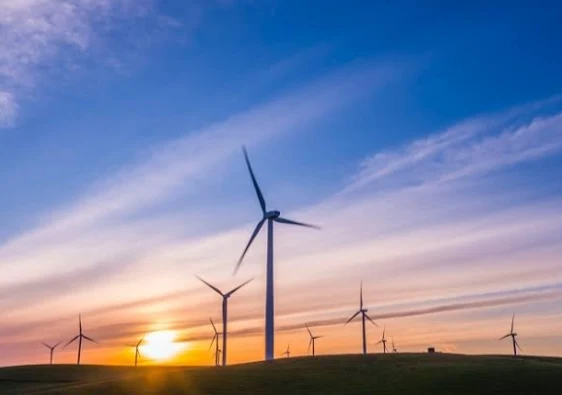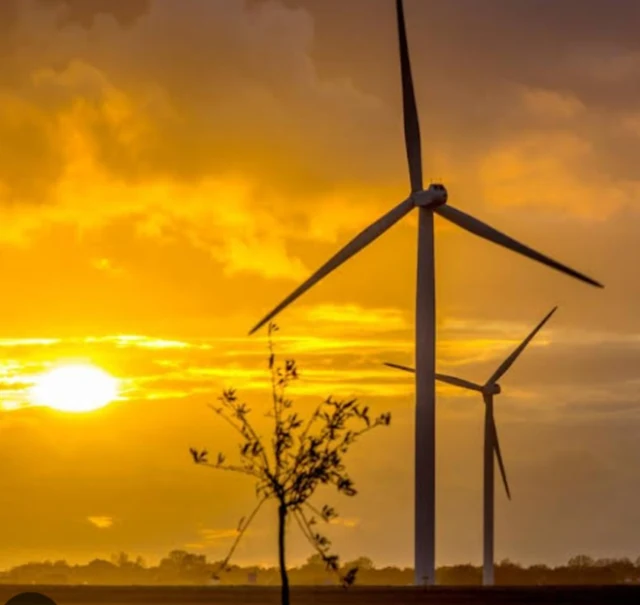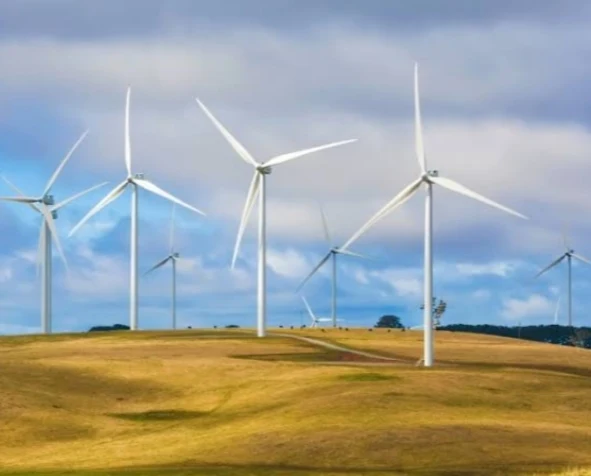UK Wind Energy Landscape: Riding the Winds of Change
The United Kingdom's wind energy landscape is a captivating tableau of towering turbines, sweeping seascapes, and a potent symbol of the country's commitment to a greener future.
From the rugged highlands of Scotland to the serene shores of Kent, the wind sings a song of renewable energy, powering homes, businesses, and the nation's ambitious decarbonization goals.
A Global Leader in Offshore Wind:
The UK stands tall as a global leader in offshore wind energy, boasting an impressive 14 GW of installed capacity as of January 2024. This translates to a forest of turbines gracefully churning amidst the North Sea and Irish Sea, their blades painting majestic arcs against the sky.
The sheer scale of these offshore feats is staggering. The Hornsea Two project, for instance, boasts an operational capacity of 1.32 GW, making it the world's largest operational offshore wind farm. These colossal wind farms are not just engineering marvels; they are testaments to the UK's unwavering dedication to harnessing the boundless energy of the wind.
UK Wind Farm Lansdcape: The Statistics
The UK boasts a diverse and impressive array of wind farms, both onshore and offshore.
Here's a UK's Wind Farm list categorized by location:
Offshore Wind Farms:
- East Coast:
- Hornsea One (1.2 GW) and Hornsea Two (1.32 GW) - Largest operational offshore wind farm in the world.
- Scroby Sands (6 MW) - One of the earliest operational offshore wind farms in the UK.
- Thanet (300 MW) - Located in the Thames Estuary.
- London Array (876 MW) - Also in the Thames Estuary, once held the title of world's largest offshore wind farm.
- North Sea:
- Beatrice (588 MW) - Located off the coast of Scotland.
- Westermost Rough (850 MW) - Also off the coast of Scotland.
- Seagreen (1.1 GW) - Situated in the Firth of Forth, Scotland.
- Irish Sea:
- Gwynt y Môr (525 MW) - Located off the coast of North Wales.
- Burbo Bank (90 MW) - Near Liverpool, England.
- West of Duddon Sands (389 MW) - Off the coast of Cumbria, England.
Onshore Wind Farms:
- Scotland:
- Whitelee Moor (539 MW) - Largest onshore wind farm in the UK.
- Aik Hill (302 MW) - Another major onshore wind farm in Scotland.
- Clyde Wind Farm (522 MW) - Located in South Lanarkshire.
- England:
- Keadby Wind Farm (68 MW) - Largest onshore wind farm in England, in North Lincolnshire.
- Robin Rigg (315 MW) - Located in Cumbria.
- Drax Wind Farm (66 MW) - Situated in East Riding of Yorkshire.
- White Hill Wind Farm (33 MW) - Near Chichester, West Sussex.
- Wales:
- Clocaenog Forest Wind Farm (35 MW) - Located in Conwy county.
- Cefn Bren (52 MW) - In Powys county.
- Pen y Garth (22 MW) - Near Llandrindod Wells.
This is just a small selection of the many wind farms in the UK. Scotland, with its abundance of windswept plains and gusty coastal regions, has emerged as the onshore wind champion.
Its vast wind farms, like Whitelee Moor and Aik Hill, generate gigawatts of clean energy, powering homes and industries while supporting the country's ambitious net-zero target.
Table of UK Wind Farm Lansdcape
UK Wind Farms: A Glimpse at the Powerhouses
| Location | Category | Wind Farm | Capacity (MW) | Notes |
|---|---|---|---|---|
| East Coast | Offshore | Hornsea Two | 1.32 | World's largest operational offshore wind farm |
| East Coast | Offshore | Hornsea One | 1.2 | |
| East Coast | Offshore | Scroby Sands | 6 | One of the earliest operational offshore wind farms |
| East Coast | Offshore | Thanet | 300 | Located in the Thames Estuary |
| East Coast | Offshore | London Array | 876 | Once held the title of world's largest offshore wind farm |
| North Sea | Offshore | Beatrice | 588 | Located off the coast of Scotland |
| North Sea | Offshore | Westermost Rough | 850 | Also off the coast of Scotland |
| North Sea | Offshore | Seagreen | 1.1 | Situated in the Firth of Forth, Scotland |
| Irish Sea | Offshore | Gwynt y Môr | 525 | Located off the coast of North Wales |
| Irish Sea | Offshore | Burbo Bank | 90 | Near Liverpool, England |
| Irish Sea | Offshore | West of Duddon Sands | 389 | Off the coast of Cumbria, England |
| Scotland | Onshore | Whitelee Moor | 539 | Largest onshore wind farm in the UK |
| Scotland | Onshore | Aik Hill | 302 | |
| Scotland | Onshore | Clyde Wind Farm | 522 | Located in South Lanarkshire |
| England | Onshore | Keadby Wind Farm | 68 | Largest onshore wind farm in England |
| England | Onshore | Robin Rigg | 315 | Located in Cumbria |
| England | Onshore | Drax Wind Farm | 66 | Situated in East Riding of Yorkshire |
| England | Onshore | White Hill Wind Farm | 33 | Near Chichester, West Sussex |
| Wales | Onshore | Clocaenog Forest Wind Farm | 35 | Located in Conwy county |
| Wales | Onshore | Cefn Bren | 52 | In Powys county |
| Wales | Onshore | Pen y Garth | 22 | Near Llandrindod Wells |
Notes:
- This table includes a selection of notable wind farms, both onshore and offshore, across various regions of the UK.
- Capacity figures are listed in megawatts (MW).
- The "Notes" column provides additional information about some of the wind farms, such as their historical significance or unique features.
Onshore Breezes Adding to the Chorus:
Onshore wind farms may not have the same oceanic grandeur as their offshore counterparts, but they contribute significantly to the UK's renewable energy tapestry. With around 13 GW of installed capacity, these turbines, often nestled amidst rolling hills and verdant fields, add a touch of modern elegance to the rural landscape.
Statistics of the UK's Wind Energy Lansdcape
UK Wind Energy Landscape: A Statistical Portrait
The UK's wind energy landscape is a captivating tapestry of towering turbines, sweeping coastlines, and unwavering commitment to a greener future. Let's delve into some key statistics that paint a picture of this impressive renewable energy source:
Capacity and Generation:
- Installed Capacity: As of January 2024, the UK boasts a total installed wind energy capacity of over 28.5 GW, with roughly equal contributions from onshore (14.1 GW) and offshore (14.4 GW) wind farms.
- Generation: In 2023, wind power accounted for a remarkable 26.8% of the UK's electricity generation, contributing over 75,610 GWh of clean energy. This is enough to power approximately 8.4 trillion LED light bulbs!
Growth and Future Aspirations:
- Rapid Growth: Wind energy has witnessed remarkable growth in the UK, with electricity generation from wind increasing by a staggering 715% from 2009 to 2020.
- Ambitious Targets: The UK government has set ambitious targets for further expanding its wind energy capacity. The aim is to reach 40 GW of offshore wind by 2030, quadrupling the current capacity.
Economic Impact:
- Investment Magnet: The UK's wind energy sector has attracted over £45 billion in investment, creating over 30,000 jobs. This contributes significantly to the nation's economy and green job market.
Challenges and Opportunities:
- Grid Integration: Integrating large amounts of intermittent wind power into the grid presents challenges, requiring investment in energy storage and smart grid technologies.
- Public Perception: Public opinion on wind farms can be divided, with some communities welcoming the economic benefits and clean energy, while others raise concerns about visual impact and noise pollution.
- Finding Suitable Locations: Identifying suitable locations for both onshore and offshore wind farms can be tricky, balancing energy production needs with environmental and community considerations.
Here are some additional statistics to paint a more detailed picture:
- Largest operational offshore wind farm: Hornsea Two (1.32 GW)
- Largest onshore wind farm: Whitelee Moor (539 MW)
- Average load factor for onshore wind: 26.34%
- Average load factor for offshore wind: 40.58%
- Equivalent CO2 reductions from wind in 2023: 56.7 million tonnes
The UK's wind energy landscape is characterized by rapid growth, ambitious targets, and ongoing challenges. As the country strives for a cleaner and more sustainable future, wind energy is sure to play a central role in its energy mix.
Table Statistics of the UK's Wind Energy Lansdcape
UK Wind Energy: A Statistical Powerhouse
The UK's wind energy landscape is a force to be reckoned with, generating clean energy and powering homes and businesses across the nation.
Here's a concise table showcasing some key statistics:
| Aspect | Statistic | Details | Image |
|---|---|---|---|
| Total Installed Capacity | 28.5 GW (as of Jan 2024) | Roughly equal contributions from onshore (14.1 GW) and offshore (14.4 GW) wind farms. | |
| Generation | 26.8% of UK's electricity in 2023 | Contributed over 75,610 GWh of clean energy, enough to power 8.4 trillion LED light bulbs! | |
| Growth | 715% increase in wind-generated electricity from 2009 to 2020 | A remarkable testament to the UK's commitment to renewable energy. | |
| Future Targets | 40 GW of offshore wind by 2030 | Quadrupling the current capacity, showcasing ambitious goals for a sustainable future. | |
| Economic Impact | Over £45 billion investment | Creating over 30,000 jobs and boosting the green job market. | |
| Challenges | Grid integration, public perception, and finding suitable locations | Balancing energy production with environmental and community considerations. | |
| Largest Offshore Wind Farm | Hornsea Two (1.32 GW) | A titan of the seas, generating clean energy on a massive scale. | |
| Largest Onshore Wind Farm | Whitelee Moor (539 MW) | A champion on land, powering homes and businesses with its impressive capacity. |
This table provides a snapshot of the UK's wind energy landscape, highlighting its current state, impressive growth, and ambitious future plans.
Ambitious Horizons: Setting Sail for 40 GW:
The UK's wind energy journey is far from over. The government has set its sights on an ambitious target of 40 GW of offshore wind capacity by 2030, a fourfold increase from the current level. This translates to a future dotted with even larger and more powerful offshore wind farms, venturing deeper into the embrace of the sea.
UK's Wind Energy Lansdcape: Fueling a Renewable Future:
The impact of wind energy on the UK's energy mix is undeniable. Wind now accounts for nearly a quarter of the nation's electricity generation, a remarkable feat that displaces fossil fuels and mitigates climate change.
Every whirring turbine blade whispers a promise of a cleaner, more sustainable future.
Challenges and Opportunities: Navigating the Winds of Change:
Integrating massive amounts of intermittent wind power into the grid presents a unique challenge. Investing in energy storage solutions and smart grid technologies becomes crucial to ensure a stable and reliable electricity supply.
Public opinion on wind farms can also be a double-edged sword. While some communities welcome the economic benefits and clean energy, others raise concerns about visual impact and noise pollution. Finding a balance between harnessing the wind's power and respecting the concerns of local communities is key to ensuring the sustainable development of wind energy.
A Landscape in Flux:
The UK's wind energy landscape is a dynamic entity, constantly evolving and adapting. It is a landscape of innovation, where engineers push the boundaries of technology to build ever-more efficient and powerful turbines. It is a landscape of collaboration, where government, industry, and communities work together to chart a sustainable course.
As the UK sails towards a net-zero future, the wind will undoubtedly be its faithful companion. The rhythmic whoosh of turbine blades will serve as a constant reminder of the nation's unwavering commitment to a cleaner, greener tomorrow. So, let us raise a toast to the UK's wind energy landscape, a testament to human ingenuity and a beacon of hope for a more sustainable planet.






